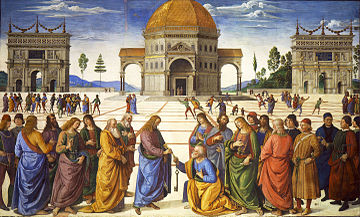Delivery of the Keys
| Delivery of the Keys | |
|---|---|
 | |
| Artist | Pietro Perugino |
| Year | c. 1481–1482 |
| Type | Fresco |
| Dimensions | 330 cm × 550 cm (130 in × 220 in) |
| Location | Sistine Chapel, Vatican City |
The Delivery of the Keys, or Christ Giving the Keys to Saint Peter is a fresco by the Italian Renaissance painter Pietro Perugino which was produced in 1481–1482 and is located in the Sistine Chapel, Rome.
History
The commission of the work originated in 1480, when Perugino was decorating a chapel in the Old St. Peter's Basilica in Rome. Pope Sixtus IV was pleased by his work, and decided to commission him also the decoration of the new Chapel he had built in the Vatican Palace. Due to the size of the work, Perugino was later joined by a group of painters from Florence, including Botticelli, Ghirlandaio and others.[citation needed]
While the work was still being created, a visit from Alfonso II of Naples resulted in his addition to the far left of the group of foreground figures. To balance out the image, an apostle was added above St. Peter.[1]
Description

The scene, part of the series of the Stories of Jesus on the chapel's northern wall, is a reference to

The style of the figures is inspired by Andrea del Verrocchio.[7] The active drapery, with its massive complexity, and the figures, particularly several apostles, including St. John the Evangelist, with beautiful features, long flowing hair, elegant demeanour, and refinement recall St Thomas from Verrocchio's bronze group in Orsanmichele. The poses of the actors fall into a small number of basic attitudes that are consistently repeated, usually in reverse from one side to the other, signifying the use of the same cartoon. They are graceful and elegant figures who tend to stand firmly on the earth. Their heads are smallish in proportion to the rest of their bodies, and their features are delicately distilled with considerable attention to minor detail.
The octagonal temple of Jerusalem[citation needed] and its porches that dominates the central axis must have had behind it a project created by an architect, but Perugino's treatment is like the rendering of a wooden model, painted with exactitude. The building with its arches serves as a backdrop in front of which the action unfolds. Perugino has made a significant contribution in rendering the landscape. The sense of an infinite world that stretches across the horizon is stronger than in almost any other work of his contemporaries, and the feathery trees against the cloud-filled sky with the bluish-gray hills in the distance represent a solution that later painters would find instructive, especially Raphael.[citation needed]
The building in the center is similar to that in
Legend
The fresco was believed to be a good omen in Papal conclaves: superstition held that the cardinal who (as selected by lot) was housed in the cell beneath the fresco was likely to be elected. Contemporary records indicate at least three popes were housed beneath the fresco during the conclaves that elected them: Pope Clement VII, Pope Julius II, and Pope Paul III.[8]
References
- ^ Decker, Heinrich (1969) [1967]. The Renaissance in Italy: Architecture • Sculpture • Frescoes. New York: The Viking Press. p. 281.
- ^ Matthew 16:19
- ^ Earls 1987, p. 127
- ^ "Perugino Archived 2012-03-22 at the Wayback Machine". UXL Encyclopedia of World Biography, 2003. Retrieved on June 2, 2008.
- Latin: Thou hast consecrated this immeasurable Temple of Solomon, oh Sixtus IV, with unequaled riches beyond [the requirements of] religion).
- ^ ISBN 0810934469.
- from the original on 2022-03-19, retrieved 2011-05-03.
- ^ Chambers, DS. 1978. "Papal Conclaves and Prophetic Mystery in the Sistine Chapel". Journal of the Warburg and Courtauld Institutes, Vol. 41: 322–326.
Works cited
- Earls, Irene (1987). Renaissance Art: A Topical Dictionary. ABC-CLIO. ISBN 978-0-313-24658-6.
Further reading
- Garibaldi, Vittoria (2004). "Perugino". Pittori del Rinascimento. Florence: Scala.
